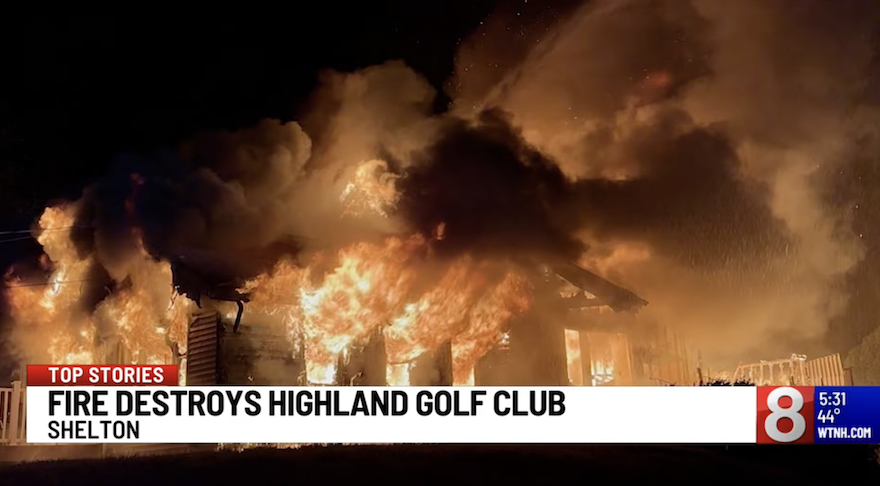Historic Golf Clubhouse Propane Destruction
On November 15, 2024, a devastating fire destroyed the historic clubhouse at Highland Golf Club in Shelton, Connecticut, just months before the club celebrated its 125th anniversary. This incident serves as a critical lesson for professionals managing cultural and historic buildings.

The Building
The clubhouse, constructed in 1927, had served as the social and operational hub of the golf club for nearly a century. Like many historic clubhouses of its era, the building underwent modifications and expansions over the years to accommodate changing requirements. The structure featured a prominent wall-to-ceiling fieldstone fireplace in the Lance Boros Memorial Dining Room—one of the few elements to survive the fire together with a damaged brick wall and the stone chimney. The building’s functions included:
- Full-service restaurant and bar
- Banquet hall for private events and club functions
- Social gathering place for members
- Archive of club history, housing photographs, records, hole-in-one boards, and memorabilia dating back to the early 1900s.
Based on the period of construction and fire behaviour, the building was likely constructed with wood-frame construction, typical of early 20th-century recreational facilities.
The Incident
Firefighters responded to 261 Wooster Street shortly before midnight on November 15 after reports of large flames. Upon arrival, they discovered that the fire had already spread to the roof and was rapidly engulfing the structure.
The last person had departed the premises around 6 p.m., indicating that the building had been unoccupied for approximately six hours before the fire was detected, that proved catastrophic.
According available news, the main factor that exacerbated the emergency seems to have been propane tanks. Multiple propane tanks on the property—used for kitchen operations (cooking equipment, pizza oven), heating, and water heating—were involved in the fire. One 100-pound container experienced a catastrophic Boiling Liquid Expanding Vapour Explosion (BLEVE), significantly intensifying the blaze.
Live power line were also ablaze, complicating firefighting operations, while strong winds and arid conditions not only fueled the main fire but also ignited several brush fires in the surrounding area, posing a threat to nearby residential properties.
It was a dry, windy night, and crews also had to put out brush fires after embers from the structure fire floated through the air and landed behind nearby homes. Mutual aid from neighbouring departments was necessitated to contain the fire’s spread.
Fortunately, no injuries were reported. However, the building was declared a total loss.
Losses
Beyond the physical structure, the fire destroyed generations of irreplaceable historical materials like photographs and records documenting the club’s founding in 1900, boards detailing club champions, past presidents, and hole-in-one achievements, tournament records and historical images of the club’s founders and decades of accumulated memorabilia chronicling the social and sporting life of the community.
These archival losses underscore a critical vulnerability in many historic buildings: cultural artefacts are often stored within the same combustible structures they document.
Investigation
The Fire Marshal and insurance investigators examined the scene butat the time this post is published, were unable to ascertain the fire’s cause. Arson seems to have been ruled out. The six-hour interval between building closure and fire discovery, coupled with the building’s unoccupied status, restricted potential witness evidence
Risk management implications for heritage buildings
This incident underscores the critical considerations for cultural heritage professionals regarding the risk associated with propane storages. Historic buildings repurposed for food service, heating, or special events often rely on propane systems. These systems pose significant hazards, as they can experience catastrophic failures (BLEVEs) when exposed to fire. Moreover:
- buildings that serve multiple functions, such as restaurants, banquet halls, and archives, face compounded vulnerabilities. These include:
- Kitchen equipment introducing ignition sources
- Food service operations leading to grease accumulation
- Event hosting potentially resulting in inconsistent fire safety protocols
- Higher occupancy during events compared to routine operations
- archive protection of irreplaceable historical materials require dedicated attention. Standard practices should include:
- Implementing digital preservation initiatives
- Storing original materials in separate, fire-rated spaces
- Considering off-site backup storage for critical items
- Regular digitization of photographs, records, and documents
Construction Considerations
Early 20th-century wood-frame buildings pose inherent vulnerabilities. These include:
- Aged timber and historic finishes, which are highly combustible
- Additions and modifications that may compromise original fire-stopping measures
- Hidden voids and spaces that can allow fire to spread undetected
- Retrofitting modern fire suppression systems may be challenging without compromising the historic fabric.
Weather and Environmental Factors
The dry and windy conditions on November 15 created an ideal scenario for fire risk escalation. To mitigate these risks, risk assessment should consider the following measures:
- Conducting seasonal risk assessments to inform operational decisions
- Implementing enhanced precautions during high-risk weather periods
- Managing vegetation around historic structures
- Coordinating with local fire services regarding seasonal risks
The loss of Highland Golf Club’s historic clubhouse underscores the need for comprehensive fire risk management strategies that specifically address the distinctive vulnerabilities of historic buildings repurposed for contemporary uses.




